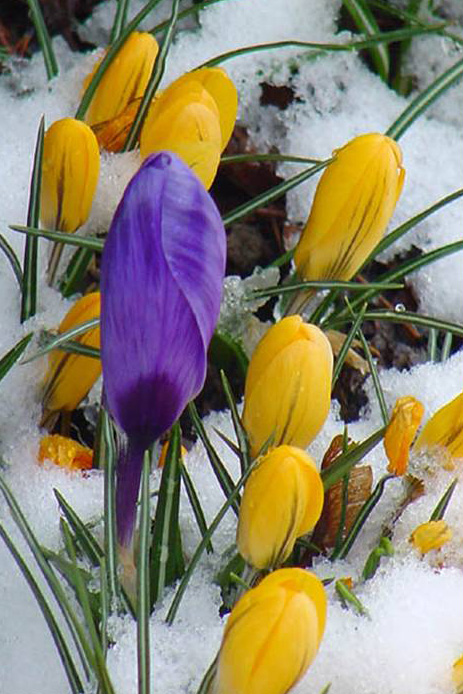| The objective of this project is to create, characterise and exploit a germplasm collection (bank) in Crocus species, including saffron crocus (C. sativus Linn.). | |
|
We propose the generation of a germplasm bank of genus Crocus . This collection has two main goals: First, to collect and reproduce saffron bulbs, coming from all the countries that cultivate saffron, for direct use of this plant material in selection programmes all over the world; and second, to create a collection of saffron allies for conservation, since they are endangered and threatened taxa and populations in Crocus , and for research in taxonomy and evolution, genetics, physiology, ecology and agronomy. This Crocus species are exploitable sources of resistances and other agronomical interesting traits to be transferred to saffron, through appropriate breeding programmes and technological tools. Resistance to fungi and other stresses are actually priorities in saffron breeding. The general objective can be divided into the following actions :
1) Exploration and collection of germplasm of saffron and related species. The collection of Crocus material will be carried out by means of requests to different regional centres growing the plants and visiting specific locations at appropriate date to collect both cultivated saffron and wild species. The taxa included in this project shape a proposal of maximum achievements. The reality of the field work is taken into account regarding the number of Crocus species and subspecies that we are able to collect.
2) Elaboration of a list of descriptors for the characterisation of the genus Crocus and primary characterisation of the collected material.
3) Multiplication of the collected plant material for its conservation in the Bank of Plant Germplasm of Cuenca, (Spain). Conservation methods based on tissue culture techniques will be used when required.
4) Elaboration of an effective documentation system, with the passport and characterisation data of the accessions, in order to guaranty an appropriate management of the Crocus germplasm collection.
5) To make available this material to potential users by distribution of corms, tissue culture and DNA samples. |
|
|
We will elaborate a list of descriptors for the characterisation of the genus Crocus and primary characterisation of the collected material. For the characterisation/evaluation of the material we will take into consideration phenotypic characters with good heritability at different structural and physiological levels and include both simple, single-gene autoapomorphic characters and complex quantitative traits:
1) Morphological: Floral features, corm size 2) Phenological: Flowering and relationship of climate, latitude and altitude 3) Cytological characterisation: Chromosome numbers, genome size, ploidy level and identification of hybrids 4) Phytochemical: Chemical composition of saffron using chromatographic [GC/MS, HPLC/MS] and spectroscopic (IR, Raman, UV-Vis etc] techniques; metabolic profiling) 5) Molecular: DNA Analysis (AFLPs, SNPs, SSRs, etc.) 6) Physiological: Abiotic stresses and pathogen responses
|
|
1) Rationalization of the collections.
2) Definition of valuable germplasm for saffron breeding.
3) Identification of ecologically rare and important species/genotypes in the natural environment.
4) Identification of valuable species, cultivars and hybrids for the horticultural industry.
5) Comparative genomics with model and crop species to identify universal features and valuable genes for agronomy.
|
|
Saffron is the most valuable food product per gram anywhere and one of the oldest organic crops and traditional (although unproven) medicinal plants, as well as a significant part of the Eurasian cultural inheritance. Saffron crop fits very well into the EU agricultural policy because is a source of high-value products with added-value from processing; use of sustainable and ecologically friendly cultivation methods; its nature of perennial crop makes an optimum use of water resources and minimize erosion, and could become a niche crop for poorer rural communities as it was in the past for centuries.
Astonishingly, before the project, no European or non-European institution has taken the responsibility of the creation and maintenance of a collection representative of the genetic variability of the crop and its allies. In the Directory of European Institutions which maintains germplasm collections only is quoted a bank that preserves a single Crocus accession without additional specification (1). We are aware that even at a world scale level there is not a Crocus collection institutionally protected and at the disposal of potential users. Regarding the characterisation, and due to its minority nature, no descriptor list has been published to be used for characterisation and evaluation of C. sativus plant material for preservation. Due to that, the elaboration and publication through the Bioversity International, of a complete list of descriptors for characterization of Crocus genus becomes also a duty for this project. If there is not any preserved material or descriptors for its characterisation, it is obvious that there must be no data on characterisation of saffron germplasm. It means that the data generated in the present project will be the first ones to be available for the potential user, together with the plant material itself. In order to give wider diffusion to these results, we will create a database following the international standards for the management of germplasm collections (2), accessible via Internet.
(1) Frison, E.A. and Serwinski, J. (Eds.). 1995. Directory of European Institutions holding Crop Genetic Resources Collections. International Plant Genetic Resources Institute, Rome . (2) Lipman, E., Jongen, M.W.M., Van Hintum, T.J.L., Gass, T. and Maggioni, L. 1997. Central Crop Databases: Tools for Plant Genetic Resources Management. Report of a workshop, 13-16 October 1996. Budapest . International Plant Genetic Resources Institute, Rome . |
|


